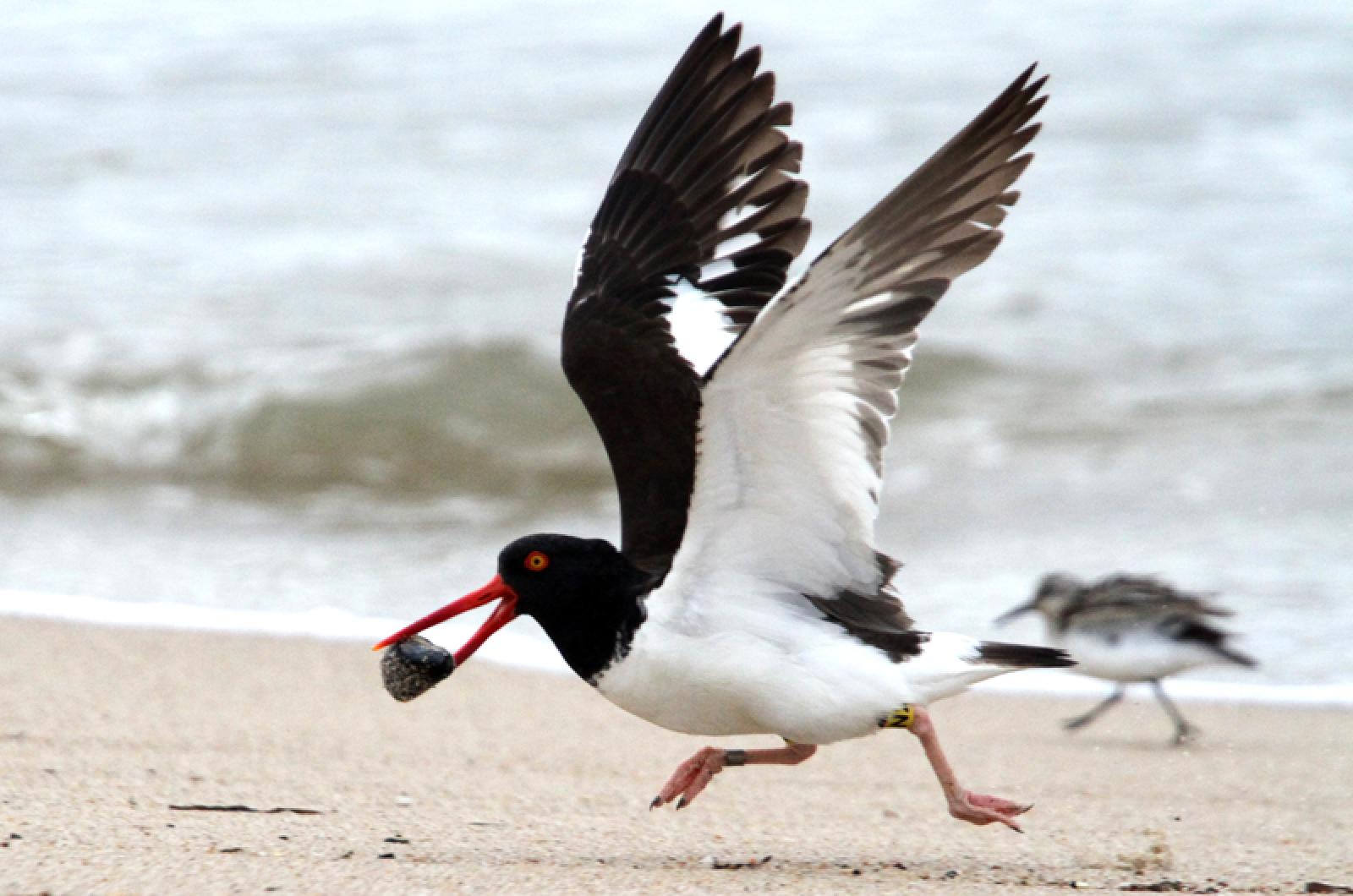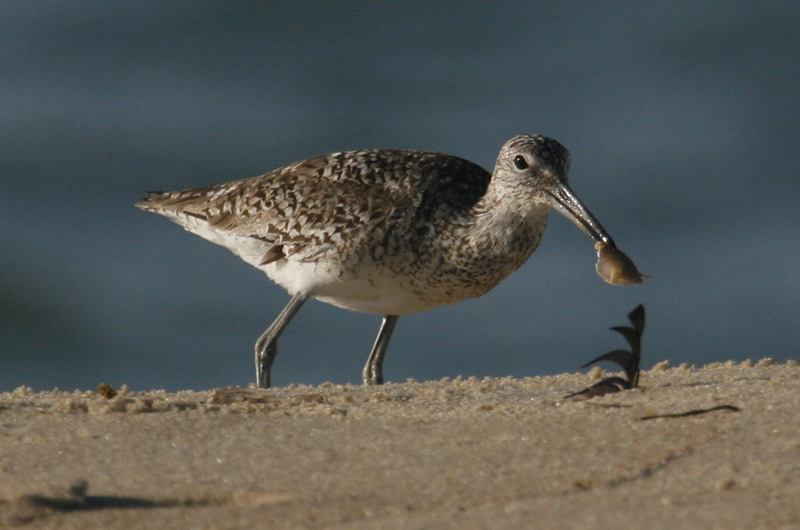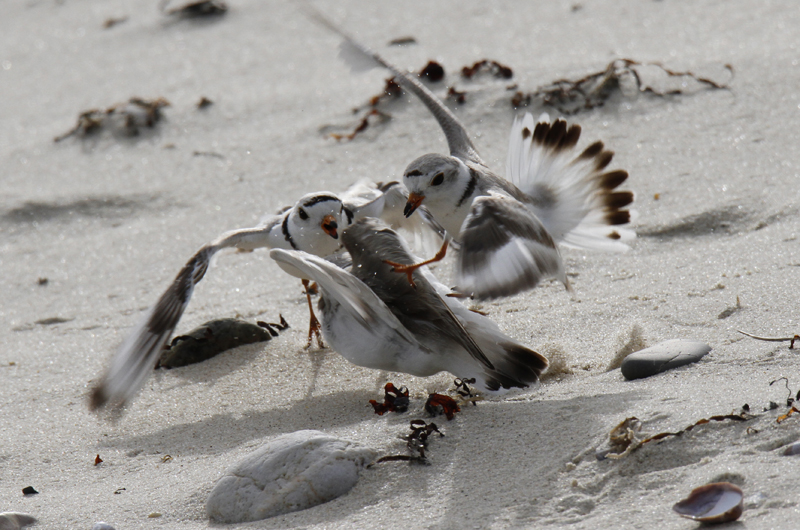The shorebird nesting season is long over and most of the nesting species are long gone to their more southern non-breeding season homes. There is a huge state-wide effort to determine population sizes and nesting success. Here on the Island the organizations involved in this effort include BiodiversityWorks, The Trustees of Reservations, Martha’s Vineyard Land Bank Commission, Felix Neck Wildlife Sanctuary, and Sheriff’s Meadow Foundation. Thank you to these organizations for compiling these important data. And readers please beware, there are a lots of numbers required when we are reporting population sizes of multiple species.
Of the 676 breeding pairs of piping plovers found in Massachusetts in 2017, only 48 pairs nested on the Vineyard, a strong decrease from the 2015 high of 70 pairs. The last time the Vineyard was below 50 breeding pairs was in 2010. Only 37 chicks were fledged, which is the third lowest productivity since 1990 and well below the estimated 1.25 chicks fledged per pair that is necessary to maintain a stable population. This low productivity is due to the weather (wave wash and heavy rain), skunk predation and crow predation. This low productivity needs to improve through management that will reduce the latter two causes of mortality.
American oystercatchers fared little better. State-wide there were 173 breeding pairs, the second lowest total since 2006. Forty-three pairs nested on the Vineyard, more than any other region of the state (Nantucket was a close second with 40 breeding pairs).
The Vineyard generally hosts small proportions of nesting terns in the State. These are the feisty birds that will dive-bomb you when you are too close to their nesting colonies. The Vineyard hosted about 16 per cent of the State’s least terns (478 of 3,008 breeding pairs) with our largest colony numbering 210 pairs on the Cape Pogue Elbow. We hosted less than one per cent of the state’s common terns with 119 breeding pairs on the Island, compared to almost 18,000 breeding pairs state-wide. Only 10 pairs of roseate terns nested on the Island, out of 2,256 pairs state-wide. But these small numbers are important. They have been present for several years now, which indicates that a new colony location has been established.
Black skimmers are primarily a southern species that only recently started nesting in Massachusetts. There are only 10 breeding pairs state-wide, but nine of those pairs nested on the Island.
Overall, the data from the Vineyard is not very encouraging. There is more work needed to protect these species that share our beaches. They were here long before we started recreating on our beaches.
Bird Sightings
It is hard for me to believe that it is already October. Perhaps this is because we had so many warm and muggy days in September. Special credit (blame?) for that weather goes to Hurricanes/Tropical Storms Jose and Maria.
Scott Stephens birded Aquinnah on Oct. 2 and reports finding an American Kestrel, brown thrasher, swamp sparrow, Lincoln’s sparrow, redstart, Nashville, and palm warblers, scarlet tanager, ruby-crowned kinglets, and sharp-shinned hawks. And Kate Meleney found an eastern kingbird at Crystal Lake that same day.
Five other people greeted October by birding the Gay Head Cliffs area on Oct. 1 — Ken Magnuson, Kelly Spencer, Allen Carney, Maura Fitzgerald and myself. The night before was a good night for migration; it was clear, cool and calm. Although there was only a light breeze in the morning, the birds were fairly scarce. We covered the cliffs area, Gay Head Morraine, Lobsterville, and downtown Chilmark.
The morning started with lots of catbirds and eastern towhees, a flock of a hundred or so robins, and a few song sparrows, American goldfinches, and northern mockingbirds. Starlings were flying around near the lighthouse, and a turkey vulture was flying low over the beaches below the cliffs. A few double-crested cormorants were perched on the rocks offshore and one common eider flew by.
We ended up with a respectable list of species, including 11 species of warblers: orange-crowned, prairie, Nashville, common yellowthroat, palm, northern parula, ovenbird, blackburnian, black and white, yellow-rumped, and American redstart. There were only a few individuals of each species, and they popped into view for short periods of time. We also saw tree swallow, blue headed vireo, red-eyed vireo, Philadelphia vireo, indigo bunting, house wren, scarlet tanager, eastern phoebe, ruby-crowned kinglet, and savannah sparrow. There were 18 great egrets gathered around a pond in the salt marsh at Lobsterville, and a brown thrasher was spotted near Red Beach. Overall it was a tough but rewarding morning.
Jeff Bernier found eight black-crowned night-herons perched in a dead tree at Sheriff’s Meadow Sanctuary in Edgartown on Sept. 30. He also saw a green heron and a great blue heron. On Sept. 29, Happy and Steve Spongberg reported watching a hairy woodpecker attacking a styrofoam buoy that was hanging in a tree. What was it doing? Such observations are one of the fascinating things about animal behavior.
Warren Woessner located a flock of about 15 black-bellied and golden plovers on the grassy area near the Right Fork Diner in Katama on Sept. 27.
This is the peak season for southbound migrants; please keep us up-to-date by reporting your sightings to birds@mvgazette.com.
Robert Culbert leads Saturday morning Guided Birding Tours and is an ecological consultant living in Vineyard Haven.












Comments
Comment policy »